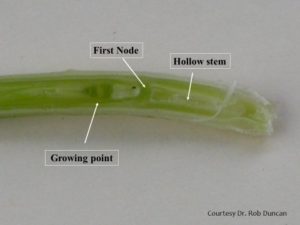by Dr. Calvin Trostle, Extension Agronomy, TAMU Dept. of Soil & Crop Sciences, Lubbock, 806-746-6101, ctrostle@ag.tamu.edu; Dr. Jake Mowrer, Extension Soil Fertility, TAMU Dept. of Soil & Crop Sciences, College Station, 979-845.5366, jake.mowrer@tamu.edu
Twelve Common Grower Questions about N for Wheat Grain
Soil & Crop Sciences extension has finalized a new publication for Texas wheat. Nitrogen topdress timing involves recognizing the key jointing growth stage in wheat, and understanding when conditions may merit earlier application of topdress N. Much of the discussion in the new document is presented in the context of twelve common grower questions about N for wheat grain, a subtitle of the publication.
Currently in 2018 topdress applications are well underway. Unfortunately, most producers are waiting for the next rain—which appears sparse—to get N movement into the root zone.
The new publication is posted at http://varietytesting.tamu.edu/wheat as well as our wheat page at the Lubbock Center, http://lubbock.tamu.edu/wheat
What is the most important growth stage in wheat? We believe it is the point at head size is set. Thus, a key element in our discussions with Texas wheat growers is an improved understanding of jointing in wheat, and why it is important (Fig. 1). And in discussing jointing, it is what is happening unseen down in the wheat stem, probably near the soil line that really matters.

Figure 1. Sliced wheat stem reveals young growing point differentiation with hollow stem to the right. Spikelet number and seeds per spikelet is likely complete.
What you visually see in the field is ‘jointing,’ that is, you notice a few stems coupled with erect growth. If you rub the lower stem between your thumb and forefinger you may feel a small ‘bee-bee,’ or node, within the stem. This means the growing point for that individual stem is differentiating, i.e., the growing point has switched over from producing another leaf to now determining potential head size (spikelet number, potential seeds per spikelet, Fig. 1). This is an important component of yield potential. Because this process for an individual head only lasts about 7 to 10 days, when you see the first few joints then most of the rest of the field has probably initiated growing point differentiation.
A sampling of the 12 questions in the topdressing guide:
- #4) If I make a ground application of N fertilizer vs. applying through an irrigation center pivot, should I change my application timing?
- #5) Is there any benefit for N applied after jointing? What if I am late applying my N, should I still do it?
- #10) Is there a limit on how much liquid N can be applied with a ground rig without burning the leaves?
Additional Wheat Resources
For further information on Texas wheat production consult the Texas A&M AgriLife wheat page at http://varietytesting.tamu.edu/wheat
You can find connections to our wheat Extension soil & crop team at http://soilcrop.tamu.edu/people-2/faculty/ These include:
- Clark Neely, State small grains Extension specialist, College Station
- Joshua McGinty, Corpus Christi
- Reagan Noland, San Angelo
- Emi Kimura, Vernon
- Calvin Trostle, Lubbock
- Jourdan Bell, Amarillo

Calvin Trostle
Professor and Extension Specialist
Lubbock, TX
803.746.6101
ctrostle@ag.tamu.edu